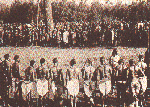 The Foundations come from the best known Dance for the Trees in Kenya on 22 July 1922. Richard St Barbe Baker, a forestry officer in the colonial service, was employed to issue timber felling licenses. His job could have been an easy one, sitting in his office by day and the comfort of the club in the evenings. But he had a conscience about his forests. He took every opportunity he could to get out, to go on long safaris through the rain forests, and to assess the annual increment of the trees with commercial value. He would never issue licenses that allowed the forest to be cut other than on a sustained yield basis.
The Foundations come from the best known Dance for the Trees in Kenya on 22 July 1922. Richard St Barbe Baker, a forestry officer in the colonial service, was employed to issue timber felling licenses. His job could have been an easy one, sitting in his office by day and the comfort of the club in the evenings. But he had a conscience about his forests. He took every opportunity he could to get out, to go on long safaris through the rain forests, and to assess the annual increment of the trees with commercial value. He would never issue licenses that allowed the forest to be cut other than on a sustained yield basis.
One day his curiosity got the better of him. He journeyed further afield, venturing first into the great bamboo forests and then eventually into the northern highlands of Kenya. Here he found a totally different situation. Instead of the lush tropical forests he found sparse scrubland. He had come to the southern fringe of the Sahel Here the native Kikuyu people followed the practice of slash and burn agriculture. The land, which was not very fertile to begin with, soon ceased to produce crops. After only a few seasons the people would be forced to move on, clearing more scrub to grow their food. What they never did was replant trees to restore the worn out soil. Trees were Shauri ya Mungu- ‘God’s business’. Their traditional enemies, the Masai, called them ‘the forest destroyers’.
St Barbe realized that if they were to learn new ways then the learning must come from within their own culture. He had long and earnest discussions with the tribal elders and eventually they agreed that trees were certainly needed, that the way to improve their land and avoid mass starvation was to plant them themselves, and that this great work, like all great African tasks to benefit the whole community, should begin with a great Dance – the Dance of the Trees.
That first great dance drew the participation of 3,000 Moran -warriors. But before he would allow the dance to proceed St Barbe chose 50 volunteers who would become the first Watu wa Miti – ‘Men of The Trees’.
Each member took a solemn promise to serve the principles of planting and caring for trees in order to save their land from turning to desert. Each kept the promise, and the secret password TWAHAMWE meaning “we are all one”. And each member dedicated his days to raising seedlings and to planting them out to make new forests to protect their homelands.
Today, the idea has spread worldwide. Men of the Trees are now active in many countries including every mainland state of Australia. World Patron is HRH The Prince of Wales.
In Western Australia the Society has been active since 1979 and today has over 1,200 voluntary members who collectively plant a third of a million trees in the season. As in Africa all those years ago Men of the Trees in Western Australia dedicate their greatest effort to preventing desertification and saving our wheatbelt from wind erosion and salt by planting masses of trees.
With thanks to Men of the Trees WA http://www.menofthetrees.com.au/
Create a ” Dance for the Trees” in Your Community
CALL 0417 244 600
